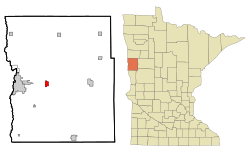Glyndon, Minnesota facts for kids
Quick facts for kids
Glyndon
|
|
|---|---|
| Nickname(s):
G-town
|
|
| Motto(s):
"A Great Place to Call Home"
|
|

Location of Glyndon, Minnesota
|
|
| Country | United States |
| State | Minnesota |
| County | Clay |
| Founded | 1872 |
| Government | |
| • Type | City Council |
| Area | |
| • Total | 1.58 sq mi (4.10 km2) |
| • Land | 1.58 sq mi (4.10 km2) |
| • Water | 0.00 sq mi (0.00 km2) |
| Elevation | 922 ft (281 m) |
| Population
(2020)
|
|
| • Total | 1,306 |
| • Estimate
(2022)
|
1,345 |
| • Density | 825.54/sq mi (318.81/km2) |
| Time zone | UTC-6 (Central) |
| • Summer (DST) | UTC-5 (CDT) |
| ZIP code |
56547
|
| Area code(s) | 218 |
| FIPS code | 27-24182 |
| GNIS feature ID | 2394918 |
Glyndon (pronounced GLIN-dən) is a small city located in Clay County, Minnesota, in the United States. As of the 2020 census, about 1,306 people lived there. Glyndon is known for its friendly community and is often called "G-town."
Contents
History of Glyndon
Glyndon was officially established in 1872. This happened when the railroad tracks were extended to this area. A post office also opened in Glyndon in 1872, helping the new community grow.
Important People from Glyndon
Many people who grew up in Glyndon have gone on to do important things. Here are a few:
- Keith Langseth: Born in Glyndon in 1938, he became a member of the Minnesota Senate. The Senate is a part of the state government that makes laws.
- Cal Larson: Born in Glyndon in 1930, he was a politician and a businessman.
- Arthur L. Peterson: Born in Glyndon in 1926, he was a politician and an educator, meaning he worked in government and also taught others.
Geography and Location
Glyndon covers an area of about 1.51 square miles (4.10 square kilometers), and all of it is land. The city was named after Howard Glyndon, which was the pen name (a fake name used by a writer) of a poet named Laura C. Redden Searing.
U.S. Route 10 is a major road that runs through the city. This road helps people travel to and from Glyndon.
Population and People
The number of people living in Glyndon has changed over the years. Here's a quick look at how the population has grown:
| Historical population | |||
|---|---|---|---|
| Census | Pop. | %± | |
| 1880 | 406 | — | |
| 1890 | 275 | −32.3% | |
| 1900 | 250 | −9.1% | |
| 1910 | 295 | 18.0% | |
| 1920 | 382 | 29.5% | |
| 1930 | 388 | 1.6% | |
| 1940 | 405 | 4.4% | |
| 1950 | 411 | 1.5% | |
| 1960 | 489 | 19.0% | |
| 1970 | 674 | 37.8% | |
| 1980 | 882 | 30.9% | |
| 1990 | 862 | −2.3% | |
| 2000 | 1,049 | 21.7% | |
| 2010 | 1,394 | 32.9% | |
| 2020 | 1,306 | −6.3% | |
| 2022 (est.) | 1,345 | −3.5% | |
| U.S. Decennial Census 2020 Census |
|||
What the 2010 Census Showed
In 2010, there were 1,394 people living in Glyndon. The city had 464 households, which are groups of people living together in one home.
- Many households (about 50.9%) had children under 18 living with them.
- Most households (65.5%) were married couples.
- The average age of people in Glyndon was about 29.5 years old.
- About 35.4% of the residents were under 18 years old.
- The population was almost evenly split between males (50.9%) and females (49.1%).
Transportation Options
While Glyndon has railroad tracks, the passenger train called the Empire Builder does not stop there. This train travels between cities like Seattle, Portland, and Chicago. If you want to catch this train, the closest station is in Fargo, which is about 10 miles (16 km) to the west.
See also
 In Spanish: Glyndon (Minnesota) para niños
In Spanish: Glyndon (Minnesota) para niños

